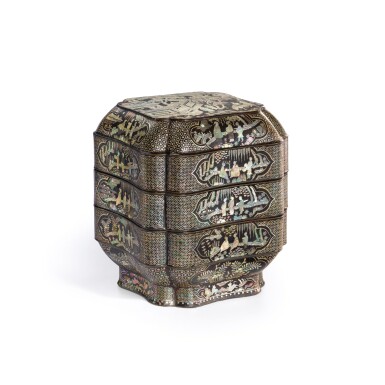Important Chinese Art including Imperial Jades from the De An Tang Collection
Important Chinese Art including Imperial Jades from the De An Tang Collection

Property from the Baoyizhai Collection 抱一齋珍藏
A magnificent and extremely rare black lacquer mother-of-pearl inlaid three-tiered square box and cover Yuan dynasty | 元 黑漆嵌螺鈿訪友圖三層委角方盒
Auction Closed
October 13, 04:27 AM GMT
Estimate
800,000 - 1,000,000 HKD
Lot Details
Description
Property from the Baoyizhai Collection
A magnificent and extremely rare black lacquer mother-of-pearl inlaid three-tiered square box and cover
Yuan dynasty
抱一齋珍藏
元 黑漆嵌螺鈿訪友圖三層委角方盒
of three-tiered square section with cusped corners and straight sides, supported on a slightly recessed splayed foot, skilfully inlaid overall in slivers of mother-of-pearl on a black lacquer ground, the raised top with a scholar arriving at a mansion with two pavilions with several attendants in the courtyard, all surrounded by cartouches enclosing figural scenes against a rural landscape on the curved sloping sides, the straight exterior walls with further similar cartouches, all reserved on a ground of interlocking circles, the sloped sides and straight foot detailed with further cartouches enclosing scenes of plants and animals respectively, all above a band of dots bordering the foot, the interior and base lacquered brownish-black save for the cinnabar top of the middle tray
20.5 by 20.5 by h. 23.5 cm
Intricately inlaid with a scene of figures in a courtyard, the present design was most probably inspired by woodblock illustrations of the period as indicated by the linearity of the composition. It is interesting to note that the craftsman has chosen to include minor details characteristic of woodblock prints to enhance the naturalism of the scene, such as the character shu (book) inscribed on the book carried by the boy on horseback and the rectangular object held by a man in the top right corner, the horse incised with a rabbit and star on its saddle and rear leg, and the hot cup of tea that has been hurriedly abandoned by its drinker, as indicated by the lines of steam rising from it.
The use of shell inlay was already in use during the Tang dynasty (618-907), when mirrors and boxes were adorned with large pieces that were finely incised for added detail. The Song craftsman employed wafer-thin shells that allowed the creation of complex pictorial scenes, which included architectural details as well as human figures with identifiable facial expressions. This technique reached new heights during the Yuan dynasty. The Ge gu yao lun (The Essential Criteria of Antiquities), written in 1387 by Cao Zhao, mentions that mother-of-pearl inlaid lacquer was produced in Jiangxi province and was popular amongst wealthy families during the Yuan dynasty and that it was made in the customer’s home in order to allow him to control quality. It also records that these Yuan pieces were favoured by the early Ming court to the degree that some were confiscated from a collector in the early Hongwu period (see Sir Percival David, Chinese Connoisseurship: The Ko Ku Yao Lun. The Essential Criteria of Antiquities, New York, 1971, pp 148-149).
A tiered box of this type, but of quatrefoil shape, was included in the exhibition Mother-of-Pearl Inlay in Chinese Lacquer Art, Tokyo National Museum, Tokyo, 1979, cat. no. 21; and another was exhibited in East Asian Lacquer. The Florence and Herbert Irving Collection, The Metropolitan Museum of Art, New York, 1991, cat. no. 58. Compare also a lobed box, in the Nezu Institute of Fine Arts, Tokyo, included in the exhibition The Colors and Forms of Song and Yuan China, Tokyo, 2004, cat. no. 131; and another of multi-lobed shape, exhibited in From Innovation to Conformity. Chinese Lacquer from the 13th to 16th Centuries, Bluett & Sons, London, 1989, cat. no. 30.
以精細的螺鈿鑲嵌庭院人物場景,應受版畫的啟發而來。甚有玩味的是工匠在細節上也用了版畫的表現手法,以增強場景的自然逼真。一童子騎在馬背上,手捧著一本刻有「書」字的書;右上角書生手捧方盤;馬鞍上刻有兔子和星星;冒著煙的熱茶。
螺鈿鑲嵌是唐代新盛的工藝,用於裝飾鏡背及奩盒。宋朝工匠運用薄而軟的貝殼,鑲嵌出複雜精細的亭台樓閣、庭院人物場景,且人物面容生動逼真。至元朝螺鈿鑲嵌技術已達頂峰,更為流行。明代曹昭著《格古要論》曰:「螺鈿器皿,出江西吉安府廬陵縣。宋朝內府中物及舊做者,但是堅漆或有嵌銅線者甚佳。元朝時富豪不限年月做,造漆堅而人物可愛。」書中也記載了元朝螺鈿器深受明初期洪武朝宮廷藏家的青睞(見大維德爵士,《Chinese Connoisseurship: The Ko Ku Yao Lun. The Essential Criteria of Antiquities》,紐約,1971年,頁148-149)。
一件類似的四棱層盒曾展出於日本,見《中國螺鈿漆器藝術》,東京國立博物館,東京,1979年,編號21。歐文伉儷舊藏一件,曾展出於《East Asian Lacquer》,大都會藝術博物館,紐約,1991年,圖版58。東京根津美術館也有例,見《宋元の美:伝来の漆器を中心に》,東京,2004年,編號131。還有一件,曾展出於《From Innovation to Conformity. Chinese Lacquer from the 13th to 16th Centuries》,Bluett & Sons,倫敦,1989年,編號30。
